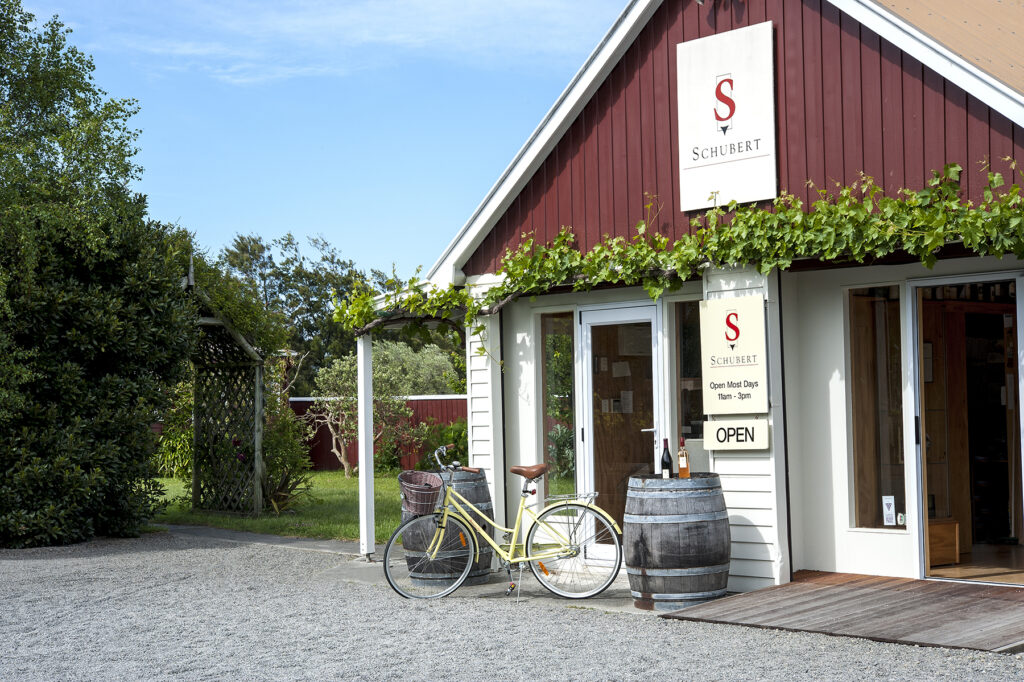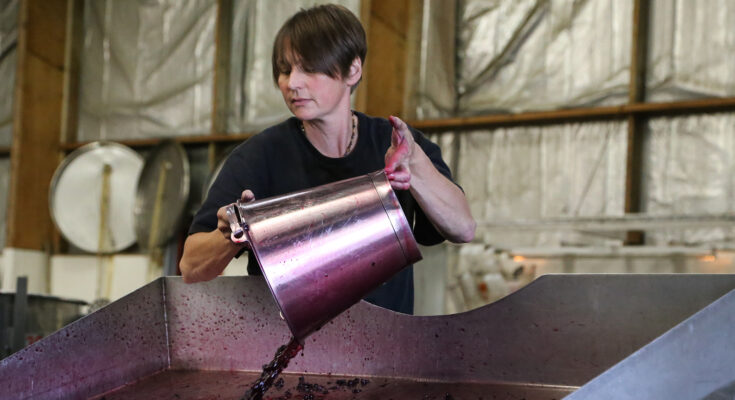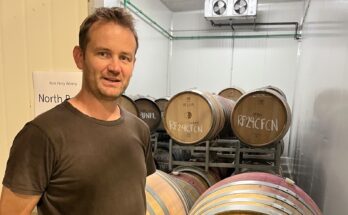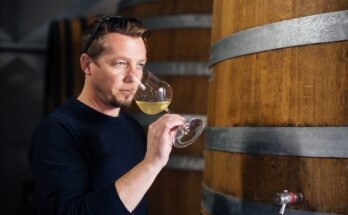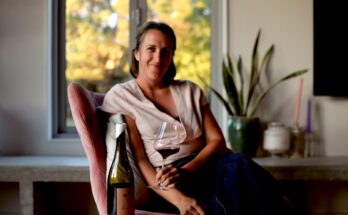On my first ‘proper’ field trip to Wairarapa, I had a day in Martinborough to talk to a few of the producers. There’s a lot more to come from more visits – it’s a great place to come and be surrounded by vineyards, wineries and just walk from one to the other at your own pace. There’s a little block of them at the end of one of the roads that leads out from the Town Square (Cambridge Road), and around Puruatanga Street is a great cluster of places to see.
I dropped in to catch up with Kai and Marion around one busy Friday lunchtime, with the Schubert Cellar Door in full swing. A food truck off to one side was dispensing really zingy, fresh, authentic Thai food, and all the outdoor tables were full. Unfortunately after a big spell of travel, Kai has come down ill, so it’s Marion who has to bear the brunt of the questions!
Marion Deimling: Welcome to Schubert wines, I’m Marion – partner of Kai, and part of the winemaking team. We started this vineyard in ’99, so we have this small block here, our Martinborough block, and our main vineyard is actually further north in East Taratahi, or Gladstone, or Dakins Road! We bought it as East Taratahi, so we still refer to it as that! Near Borthwick and Johner, right next to the Ruamahanga River on a river terrace. It was just bare land when we bought it and we planted it in 1999 and 2000, as well as this small block here. This is a nice ‘bits and pieces’ block that was an established vineyard that had been planted by an Italian, and had been named the Red Rooster. Now it is Schubert.
When we started we wanted to get more experience with New Zealand fruit, so in ’99 we actually brought in fruit from Hawke’s Bay because the wine industry was still quite small in Martinborough at that time, and couldn’t buy any Martinborough fruit. So our first red wine experience was Syrah, Cabernet Sauvignon, Merlot and even Cabernet Franc. It was quite interesting. When Craggy Range came in around the same time, they basically doubled the size of Martinborough. And now I hear another 200 hectares.
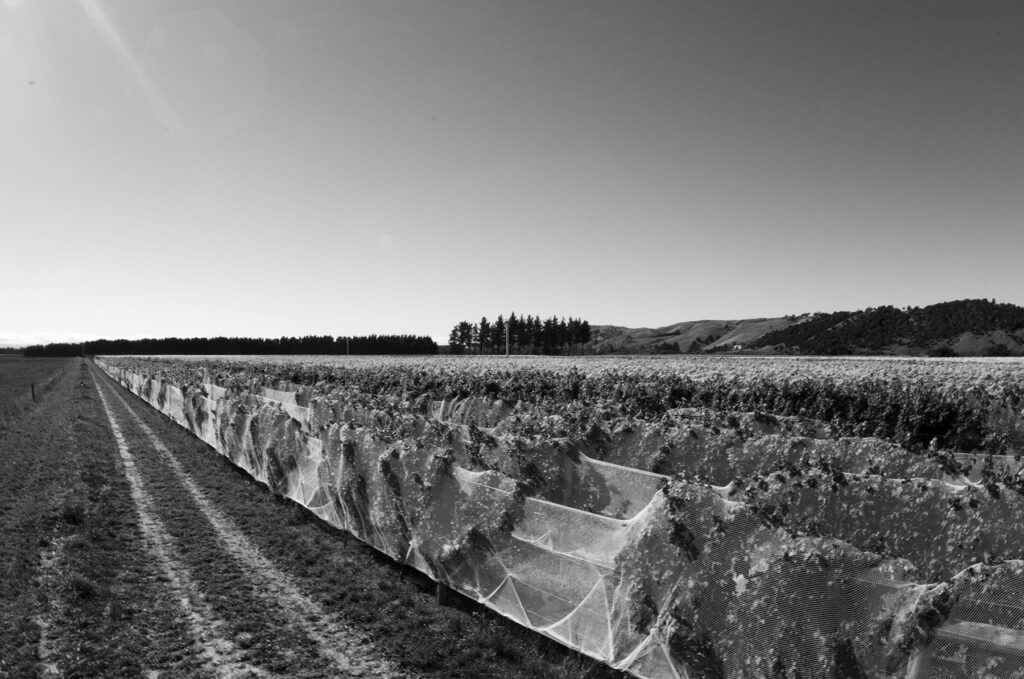
What you are tasting is our 2019 Sauvignon Blanc. Ours, like most on the North island, is more on the tropical fruits like pineapple and passionfruit, It’s partially barrel-fermented, so you get a little bit more mouthfeel to it. It has a nice acidity structure to it, but the acidity is not too overpowering. It’s well received here. People are usually quite attracted to that style.
This next wine has just been bottled yesterday. It’s a white wine blend called Tribianco, from our patchwork bits and pieces block. We have two blends – one white and one red wine bend. You don’t have to guess what’s in it, but taste first..
WF: That is interesting. I’m almost getting something unusual in there – something old fashioned? Like wines that we used to have, and it’s got a little funky note at the finish. Sometimes the blends go really well at the Cellar Door, and then you buy it and try it at home and think ’why have I bought this?’ (laughs). But this is really interesting. Riesling?
MD: No. I will tell you, otherwise it just becomes a guessing game. It’s Muller Thurgau.
WF: Right! I haven’t tasted that for a long time!!
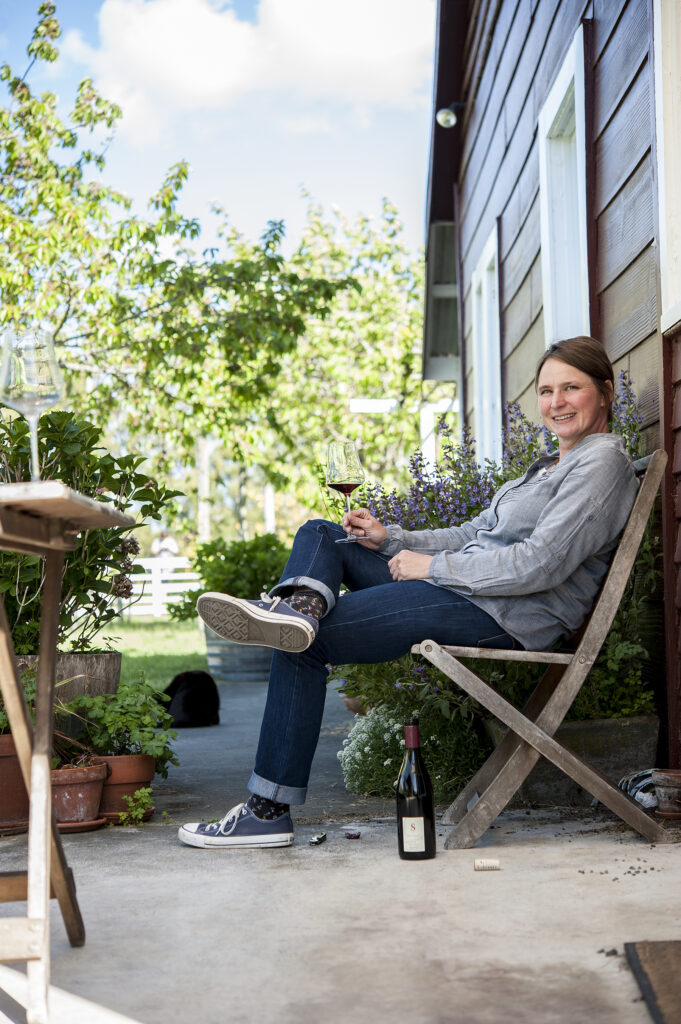
MD: It’s three parts – Tribianco. It’s a blend of Muller Thurgau, Chardonnay and Pinot Gris. Made in a traditional white Burgundy style. Barrel fermented and left on full lees for about five months, before we rack it and blend it. I think you get that nice floral component from the Muller Thurgau, like an orange blossom and then structure from Pinot Gris and the finish always reminds you of the Chardonnay. We’ve been making this since 1999, since it was all there, already planted. I’m from Lake Constance, an area in the south of Germany, and I grew up with Muller Thurgau. We said ‘let’s see what we can do with it’.
WF: I like field blends, as each gives a little to the other – and if they are growing together they just seem to create a harmony with each other. I drank German wines with some sweetness when I lived in the UK – some of those were very well regarded.
Sometimes without knowing what the grape variety was. But then I drank French “Burgundy” without knowing it was made from Pinot Noir grapes – that knowledge came later – possibly around the time that I discovered that New Zealand was making wines from Pinot Noir.
MD: It probably wasn’t that established back then. Ata Rangi is now celebrating their 40th anniversary, and I believe that Marlborough has had Pinot Noir, but they used it to make bubbles.
WF: Why did you choose Martinborough?
MD: Kai is the Pinot enthusiast, and we both studied at Geisenheim Wine University, but he always wanted to make Pinot Noir that can compete on an international level. There is plenty of German Pinot Noir, but when we started looking it was probably a bit harder to make a really nice red in Germany. We looked everywhere. France is really hard because you cannot really buy land unless you are very rich. Oregon in USA would have been an option. I was working in Victoria, Australia in a higher altitude part, and they made some nice Pinot… and then of course there was New Zealand. For us it became North island because what Central has is upfront, fruit-driven, cherry on the nose; but Martinborough is more almost on the meaty side and a little bit more savoury. This is what attracted us. And it’s a lovely area. We go for a walk in the Tararua, and only hear birds.
Our rosé is made from Pinot Noir grapes and meant to be a nice, light summer wine. Just a hint of strawberry on the nose. Quite pale in colour – we do only a short amount of skin contact with it because we don’t want to extract any of the tannins. Most of the people who come for lunchtime are sitting outside and drinking the rosé. It’s made for something like that. Sunshine.
WF: I think Pinot makes a lovely rosé.
MD: When I grew up, Pinot Noir was the only red wine variety that was classified for that area. That was the only one that you could grow, so if you wanted to make rosé this was the only variety that you could use for it. And then they have a name for it – they call it ‘white harvest’. It’s very light in colour – almost an onion skin colour. The first one we made we left overnight, so that was probably eighteen hours. That was pinker but to balance the tannins you need some residual sugar here as well.

WF: This is a delicious rosé. I like that mandarin character it has, alongside the usual white cherry, raspberry… and the acidity structure carries it nicely. Do you enter things in shows?
MD: With our Pinots we do – not with the Rosé, or the Sauvignon Blanc, no. It wouldn’t be a winner. In a line up with the full-on gooseberry on the nose wines, it wouldn’t win. We have the wines reviewed. With something like Tribianco, that is hard even on a wine list, because you will find it under ‘Other Whites’ and unless someone recommends it with a food option? At the restaurant in Martinborough on the Square, the chef had a caramelised pork belly, which they paired Tribianco with, and the sweetness from the food and the yeastiness and floral component of the wine worked really well. Unless you feel experimental, you wouldn’t normally pick something from the ‘Other White’ section.
When Kai was in Oregon there was a Pinot Conference, and one Martinborough winemaker was there as well. When his wine was tasted all the French were sure it was from their homeland, and then Dr Neil Macullum from Dry River stood up, with a smile on his face, and said ‘Its actually mine, and I’m from New Zealand’. It was another thing that pointed us towards Martinborough. When we got here the wine industry was still very young, but on the outskirts of Masterton, in Opaki, there was this guy and he produced some Riesling – and we like Riesling – who had literally read one book about winemaking and made this stunning Riesling. So we knew there must something right with the fruit already to achieve something like that, as an amateur.
WF: I’ve just been in Hawke’s Bay, and I’m always learning – so I’ve been educating myself about natural wines. Your thoughts on that?
MD: Let me get the Pinot, then we can talk, because the question is – what is a natural wine? We produce two different Pinot Noirs – Marion’s Vineyard and Block B, and of course I was named after the vineyard. We have a couple of natural winemakers in Martinborough. Urlar has a natural wine line – in Gladstone; Lance at Cambridge Road is a natural wine producer. With something like Rippon – Tinkers Bequest Pinot – this is a an un-sulphured wine, and we tasted it, and then put a little sulphur in one of the glasses… with the sulphur you get that Central Otago cherry – without it – not. So that was quite interesting. I don’t say that it’s better, or anything, but sometimes it brings out the fruit.
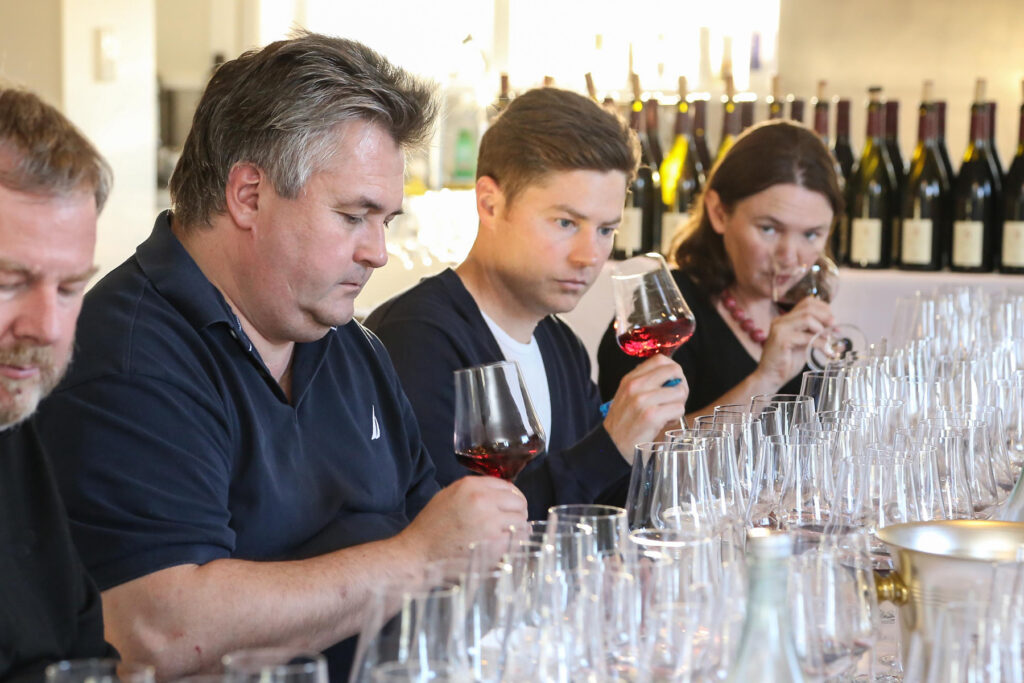
I had some amazing natural wines, but it takes a lot of time and patience. In Europe there are people who have started in the vineyard – with fungi-resistant vines, that in a good year require no spray at all, and then the wines are kept in a cool underground cellar and can take two years to complete a ferment. That’s quite a commitment. But that wine is clear. It settles itself and if you rack it carefully – I get the feeling in New Zealand that natural wine ‘needs’ to be cloudy. I think if you let gravity work and give wine time – and my philosophy is more about time, than cloudiness.
WF: Is that something you use in your winery? I read about that winery – Blackenbrook, where the guy built the winery around his principles and gravity was a part of it.
MD: Yes. It’s a single storey winery but we have a forklift and you can create a lot of gravity just that way. Yes, I’ve been to Blackenbrook – he is from Switzerland. I’m into natural wine, just not cloudy wine.
WF: What about somewhere like Pyramid Valley though – that wine was often ‘opaque’ let’s call it.
MD: That was so interesting because they were so out-of-the-box. I was at a conference and there were two people. Ernie Loosen from Loosen Estate, and a sommelier from Germany – Billy Wagner. Both of them brought me that wine and said ‘you have to try this’. They had a decanter and it was slightly cloudy and quite light in colour.
MD: We try to do low intervention and are organic certified but I am not a natural winemaker. Probably too much of a control freak to be a natural winemaker. I’m yet to try natural yeast – I’m not quite there yet. One day it will happen but in the beginning you needed every drop – you cannot lose a tank. I know what yeast is fermenting that wine. That is still quite important to me. During red wine fermentation, especially in years where you have higher alcohol potential, like 2019. Once you have older barrels in your system, malolactic fermentation starts quite naturally. The climate here is perfect for Pinot. Cooler evenings – we were sitting outside yesterday until about 8pm but then it’s too cold. If the wind stopped it would be boiling hot, but those cooler nights are a positive for a slower ripening, tannins and acidity structure. I like the prettiness in it.
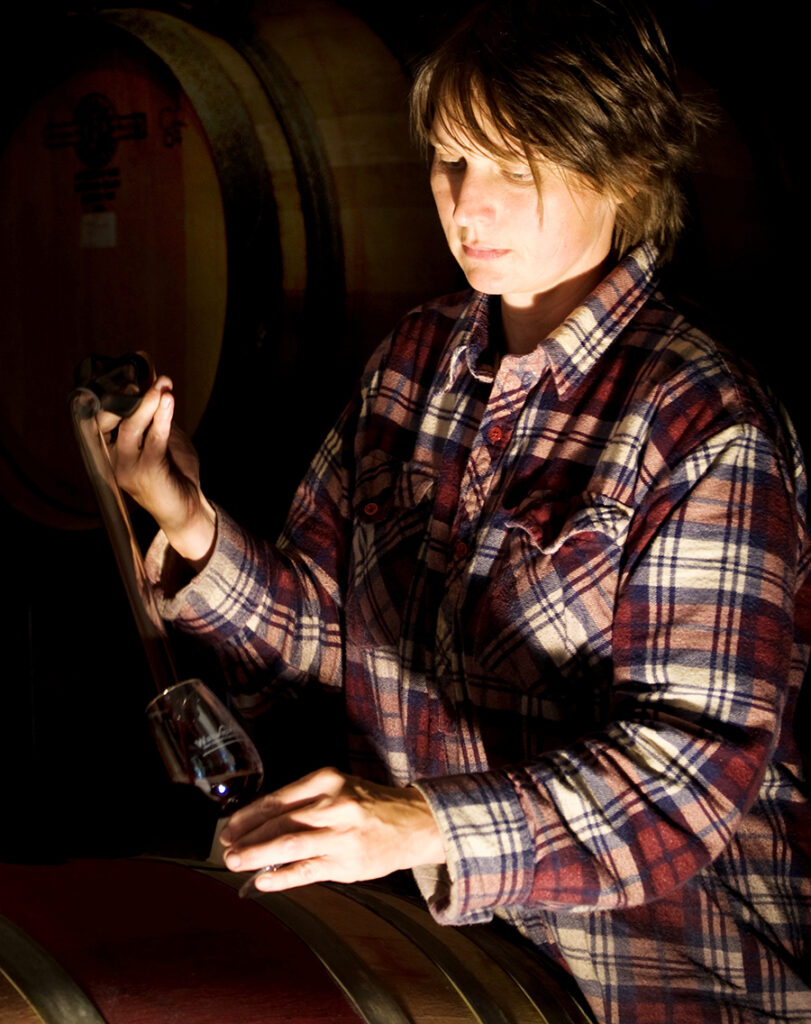
WF: Does Martinborough have more tannin, generally?
MD: I would say so. Parts of Central, like Felton Road is quite on the tannic side as well.
(pours the first red wine)
This is the 2018 Marion’s Vineyard Pinot. The difference between the two Pinots is the clonal selection. Marion’s is more the traditional clones of this area – Abel, 10/5 and Clone 5. Abel brings the spicy components on the nose and the fruit from the Clone5 – the Pommard clone and then the acidity structure from the 10/5. The flagship wine is Block B – we have three blocks and this is Dijon clone Pinot Noir from Block B. We get naturally smaller berries but you end up with a bigger, bolder wine. Typical for Schubert, you get a spicy component on the nose, then darker berries and plums come through as well. Eighteen months in French oak barriques to mellow the tannin structure. While I say this is our flagship, we don’t really see one as better than the other. There are Marion’s Vineyard fans who like its playful nature; then Block B fans who like the dense structure. This Pinot is the soul, the reason we came to New Zealand – the other stuff, we do around it.
The last vintage for harvest we did a combination of backpackers and locals for picking. The week before lockdown we didn’t know if we could pick, because no-one told us; and then we could… and then we were lucky we had four French backpackers who could stay in their campervans and were happy in there, staying in our vineyard. It’s fine for us and fine for them, because they were very concerned not to mix with people, so just happy to be there. But that won’t work like that all the time.
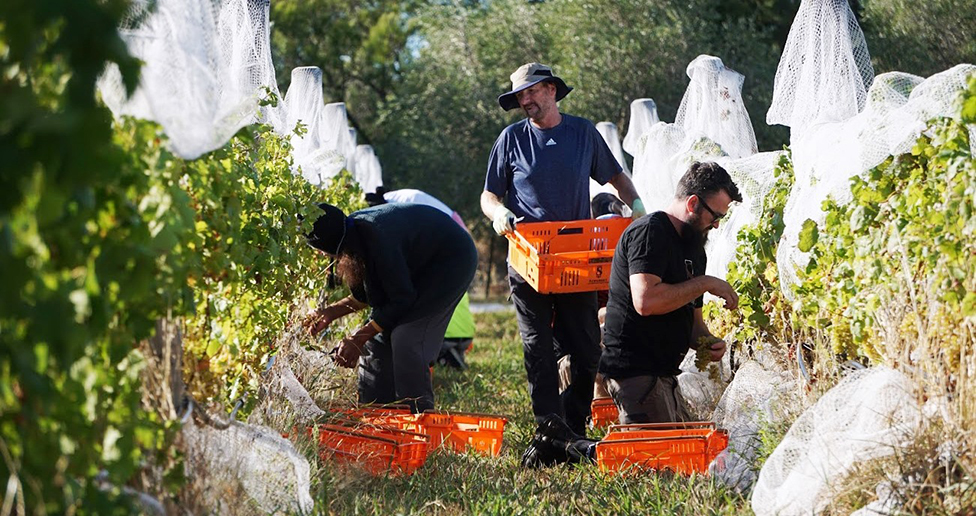
Now – 2017 Syrah. A very tricky year with a lot of rain during the vintage, but we are quite happy how this wine turned out. In the Wairarapa our Syrah is very much on the spicy side, with white pepper that goes into a nutmeg direction. We keep our Syrah for almost three years in French oak barrique. In this case there’s no new oak in it because the vintage didn’t feel like it could handle it.
WF: This is a bit different from the Syrah I have been drinking this week in Hawke’s Bay. They have a bit more of the red liquorice, but also I think there it’s a younger wine, with a bit more structure? This has a lovely cassis note, and it’s rich without being heavy.
MD: As I said, maybe I like the control – like putting yeast in my wine; but also we really like to keep them in barrels for a little bit longer. We like to soften the tannin structure, and are looking for elegance. There’s not a huge production of Syrah from Martinborough, but there are a couple of wineries with good reputations. Dry River, Kusuda, Martinborough Vineyards all make it, and Ata Rangi make a Syrah from just across the road here. It’s known for its Pinot Noir, but there are some really fine Syrahs here.
WF: Do you have a time in the year when you get that ‘feeling’?
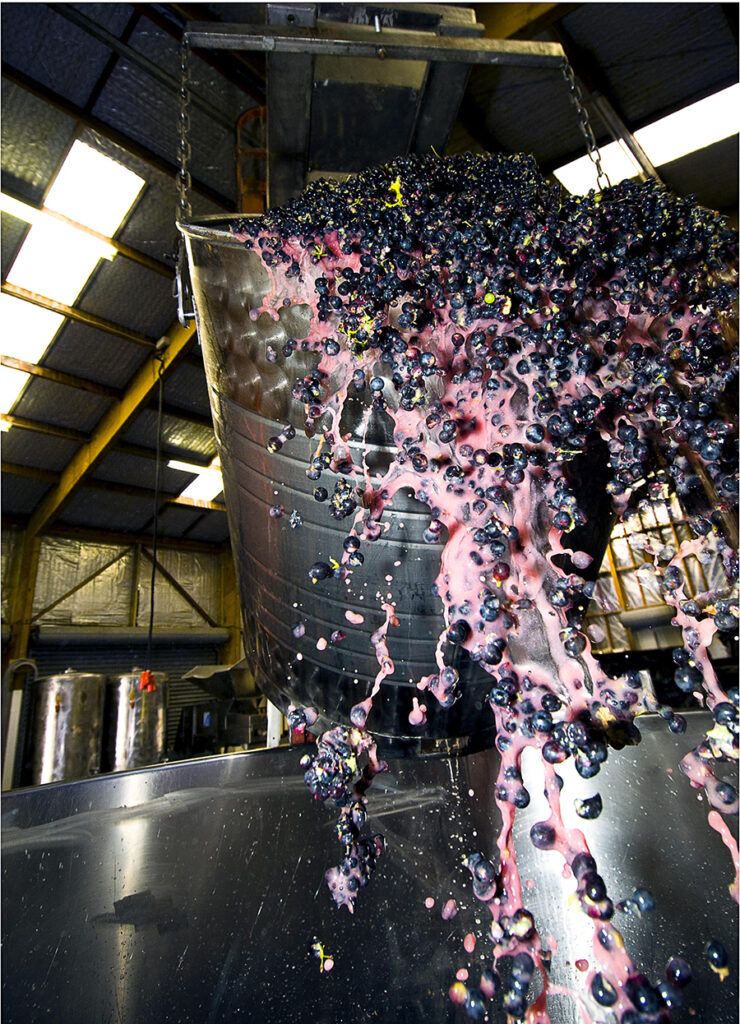
MD: I can tell you which is the hardest… the nets are on and you are waiting for the grapes to get to the point for you to be able to pick them. Once vintage starts, you are kind of in the zone. It’s day by day and then you are faced with whatever nature throws at you. You have to make decisions every day, but it’s not that one moment that has made the wine that ends up in your glass. My background is more scientific but I’m not really an analytical winemaker. These days it seems like Pinot Noir has to have the pH at 3.3, but that’s not really what we are doing. We are tasting and seeing the balance in there.
WF: Are there other varieties that you’d love to have a go at?
MD: Ahh, yes – Pinot Blanc. I love it and I think that would really go. Like Pinot Gris with more finesse, you know? But then – what is the Pinot Gris style that you prefer?
WF: Not Pinot Grigio, that’s for sure. More like it is in Alsace. And what about if you could give advice to your younger self – would you still be a winemaker?
MD: Originally I wanted to study law, but it’s probably better that I’m a winemaker – for the world! Once I started that wine journey I knew I was on the right track. After I’d finished school in Germany I went to Australia; and I worked in the vineyards, then did vintage. I wrote very enthusiastic letters back to friends, and one friend picked up on that and said I should go to school when I got back to study winemaking.
(pours one last wine)
This is our 2016 Con Brio red wine blend, that we kept four years in barrel. You can see a theme here. It’s an unusual blend and you could not find it in Europe because the three varieties do not grow in one region.
WF: It has Syrah and Pinot in it. Is the other component something unusual that I wouldn’t guess, like Petit Verdot?
MD: Or something normal – Merlot. Spicy component from the Syrah on the nose, the fruit from the Merlot and that nice round finish from the Pinot Noir. This can only happen in the New World! It’s small production and goes well in the Tasting Room, but also people don’t have to wait for another five years before they can drink it.
